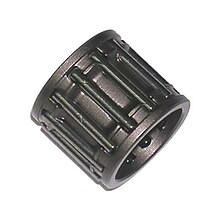Needle roller bearings
Needle roller bearings are roller bearings with a particularly low design. The rolling elements are similar to needles (hence the name needle roller bearings ), they are thin and very long cylindrical rollers. Needle roller bearings are often used in transmissions because of their small footprint.
A typical application: the so-called release bearing in a car or motorcycle. This is located between the clutch and the gearbox and only works when the clutch is depressed. As a rule, this bearing lasts at least as long as the clutch itself, and that with a very filigree design. This example shows that this type of construction can also be exposed to relatively high loads, over a long period of time and in a hot and dirty environment (clutch abrasion). This type of construction can also be found regularly in machine tools or packaging machines. Here, however, it is above all the high radial forces that arise that speak in favor of using a radial needle bearing. In addition, the installation space is often limited in this case too.
Types
- Needle roller bearings with an inner ring only require a simple drawn shaft
- Needle roller bearings without an inner ring, but with an outer ring (needle sleeve): require a polished and hardened running surface on the shaft. This can save additional installation space. The shaft then takes over the function of the inner ring. Therefore, corresponding properties (surface quality) are necessary for them.
- Needle roller and cage assembly: A rolling element cage with rolling elements (without housing) requires polished and hardened running surfaces on the shaft and on the outer track; here the overall height corresponds to the diameter of the rolling elements, i.e. the needles.
- Needle sleeve: This design is closed on one side and thus protected against the ingress of dirt.
- Adjusting needle roller bearings: without an inner ring, but with a plastic support ring between the outer ring and the needles, to compensate for slight tilting (misalignment).
All types are designed both single-row (i.e. with a row of rolling elements) and multiple-row. There are also radial and axial bearings as well as tapered roller bearings (e.g. in the bicycle headset). They can only absorb forces that act in one axis. If both axial and radial forces have to be absorbed, two bearings are required. There are also combined needle / axial deep groove ball bearings that absorb axial and radial forces. Axial needle bearings have a higher sliding component (higher friction) due to the different circumferential paths of the two rolling element ends, which has an unfavorable effect on the wear behavior.
Comparison with standard ball bearings
The advantage of the needle roller bearing is its low installation height and its high load capacity. This results from the larger contact surface in contrast to ball bearings .
The disadvantage of needle roller bearings is that their small size means that the maximum permissible speed is lower than with other types of roller bearings. It is also sensitive to “wrong” - forces that do not act in the same direction as the load.
Needle roller bearings are standardized according to DIN 616 to 618. They are similar to cylindrical roller bearings (DIN 5412), but have not historically emerged from them. Needle roller bearings are therefore not to be referred to as cylindrical roller bearings.
Individual evidence
- ↑ Lamb.de "Radial-Nadellager", accessed on December 29, 2017
- ↑ Wälzlagertechnik.eu "Needle bearings", accessed on December 29, 2017 ( Memento of the original from December 29, 2017 in the Internet Archive ) Info: The archive link was inserted automatically and has not yet been checked. Please check the original and archive link according to the instructions and then remove this notice.

